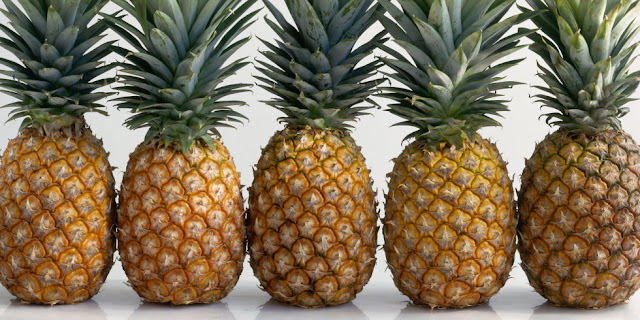Skip to main content
pineapple
Pineapple
Fruit
The pineapple is a tropical plant with an edible multiple fruit consisting of coalesced berries, also called pineapples, and the most economically significant plant in the Bromeliaceae family.


The
pineapple (Ananas comosus) is a tropical plant with an edible multiple
fruit consisting of coalesced berries, also called pineapples,and the
most economically significant plant in the Bromeliaceae family.
Pineapples
may be cultivated from a crown cutting of the fruit,possibly flowering
in 5–10 months and fruiting in the following six months. Pineapples do
not ripen significantly after harvest
Pineapples can be consumed
fresh, cooked, juiced, or preserved. They are found in a wide array of
cuisines. In addition to consumption, the pineapple leaves are used to
produce the textile fiber piña in the Philippines, commonly used as the
material for the men's barong Tagalog and women's baro't saya formal
wear in the country. The fiber is also used as a component for wallpaper
and other furnishings.
History
The
plant is indigenous to South America and is said to originate from the
area between southern Brazil and Paraguay; however, little is known
about the origin of the domesticated pineapple (Pickersgill, 1976). MS
Bertoni (1919) considered the Paraná–Paraguay River drainages to be the
place of origin of A. comosus.The natives of southern Brazil and
Paraguay spread the pineapple throughout South America, and it
eventually reached the Caribbean, Central America, and Mexico, where it
was cultivated by the Mayas and the Aztecs. Columbus encountered the
pineapple in 1493 on the leeward island of Guadeloupe. He called it piña
de Indes, meaning "pine of the Indians", and brought it back with him
to Spain, thus making the pineapple the first bromeliad to be introduced
by humans outside of the New World.[ The Spanish introduced it into the
Philippines, Hawaii (introduced in the early 19th century, first
commercial plantation 1886), Zimbabwe, and Guam. The fruit is said to
have been first introduced in Hawaii when a Spanish ship brought it
there in the 1500s. The Portuguese took the fruit from Brazil and
introduced it into India by 1550.
Charles II is presented with the first pineapple grown in England (1675 painting by Hendrik Danckerts).
The
pineapple was brought to northern Europe by the Dutch from their colony
in Surinam. The first pineapple to be successfully cultivated in
Europe, is said to have been grown by Pieter de la Court at Meerburg in
1658. In England, a huge "pineapple stove" needed to grow the plants had
been built at the Chelsea Physic Garden in 1723. In France, King Louis
XV was presented with a pineapple that had been grown at Versailles in
1733. Catherine the Great ate pineapples grown on her own estates before
her death in 1796.Because of the expense of direct import and the
enormous cost in equipment and labour required to grow them in a
temperate climate, using hothouses called "pineries", pineapples soon
became a symbol of wealth. They were initially used mainly for display
at dinner parties, rather than being eaten, and were used again and
again until they began to rot.By the second half of the 18th century,
the production of the fruit on British estates had become the subject of
great rivalry between wealthy aristocrats. John Murray, 4th Earl of
Dunmore built a hothouse on his estate surmounted by a huge stone cupola
14 metres tall in the shape of the fruit; it is known as the Dunmore
Pineapple.
John Kidwell is credited with the introduction of the
pineapple industry to Hawaii; large-scale pineapple cultivation by US
companies began in the early 1900s. Among the most famous and
influential pineapple industrialists was James Dole, who moved to Hawaii
in 1899and started a pineapple plantation in 1900. The companies Dole
and Del Monte began growing pineapples on the island of Oahu in 1901 and
1917, respectively. Dole's pineapple company began with the acquisition
of 60 acres (24 ha) of land in 1901, and grew into a major company, the
Dole Food Company. Maui Pineapple Company began pineapple cultivation
on the island of Maui in 1909.
In the US, in 1986, the Pineapple
Research Institute was dissolved and its assets divided between Del
Monte and Maui Land and Pineapple. Del Monte took cultivar '73–114',
dubbed 'MD-2', to its plantations in Costa Rica, found it to be
well-suited to growing there, and launched it publicly in 1996 as 'Gold
Extra Sweet', while Del Monte also began marketing '73–50', dubbed
'CO-2', as 'Del Monte Gold'.
Dole ceased its cannery operations
in Honolulu in 1991, and in 2008, Del Monte terminated its
pineapple-growing operations in Hawaii.In 2009, the Maui Pineapple
Company reduced its operations to supply pineapples only locally on Maui
and by 2013, only the Dole Plantation on Oahu grew pineapples in a
volume of about 0.1 percent of the world's production




Comments